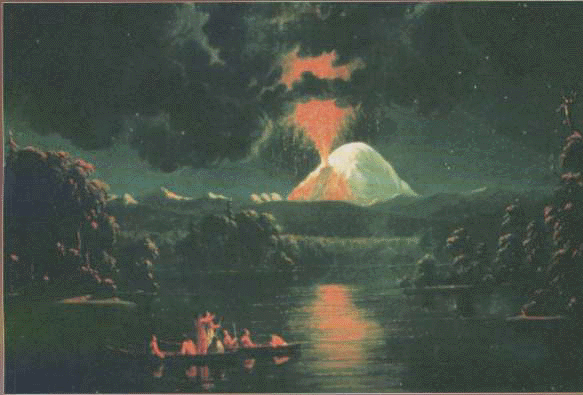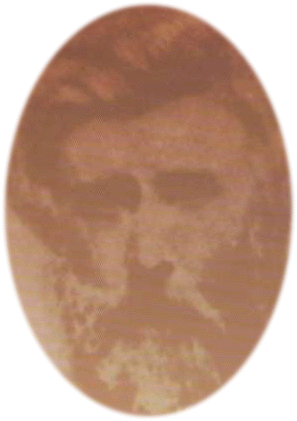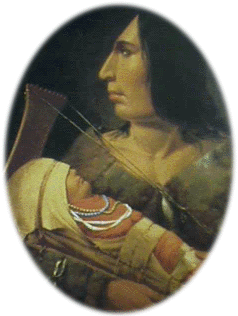 |
| On March 26, 1847, Paul Kane recorded the eruption of Mount St. Helens from the mouth of the Lewis River in the Oregon Territory. [Painting, courtesy Royal Ontario Museum/912.1.78] |
When a British army officer recommended Paul Kane to Hudson Bay governor Sir George Simpson, he wrote that Kane “would return from the west with a portfolio of sketches not much inferior to [George] Catlin’s in variety and greatly superior in truth.” Simpson also received a letter from his Hudson Bay agent at Sault Ste. Marie praising Kane’s work and assuring him that the artist “was prepared for the hardships of travel in the west.”
After he met Kane
in 1846, Sir George issued instructions to Hudson Bay officers “in Rupert’s
Land and Elsewhere” that Kane be given free transportation on company boats
and “hospitalities” at all posts.
 |
| On March 26, 1847, Paul Kane recorded the eruption of Mount St. Helens from the mouth of the Lewis River in the Oregon Territory. [Painting, courtesy Royal Ontario Museum/912.1.78] |
Kane was in his 36th year when Simpson wrote those orders. For the next two years Kane made several hundred sketches of voyageurs, buffalo hunts, Indian settlements from Fort William to Oregon Territory on the Pacific coast, and portraits of first nation peoples that reflected, as a later article declared, the life and times of “American Indians at the point of fatal contact with the white man’s culture.”
Born in Mallow, Ireland, in 1810, Kane came to the town of York (later Toronto) in Upper Canada with his family between 1819 and 1822. Although little is known of his early life, it is known that he studied art with Thomas Drury, the drawing master of Upper Canada College. In 1834, a local newsletter, The Patriot, praised Kane, concluding that “practice and study should make Mr. Kane an artist of name.”
At the time, however, according to the York Directory of 1833-34, Kane was “a coach, sign and house painter.” When he later moved to the A.W. Conger Furniture factory in Cobourg, Ontario as a decorative painter, he began to do portraits. In 1836, he went to Detroit and for the next five years painted portraits in various cities including St. Louis and New Orleans. From there he sailed to Europe in 1841.
He arrived at Marseilles,
went to Genoa and Rome where he spent time studying and copying paintings
by Murillo, del Sarto, and Raphael, and made some money selling copies
of the old masters. By October 1842, he was in London and there met the
artist with whom he is often compared, the American George Catlin, whose
work and book had been a huge success in England in 1841 and who was holding
an exhibition at Piccadilly. The exhibition and subsequent friendship peaked
Kane’s interest in painting indigenous Canadians, but he first spent time
at
Mobile, Alabama, to earn money to pay the debt incurred for his return
trip.
 |
In his lifetime, Paul Kane (1810-1871) was well known throughout North America and Europe as the most famous of all Canadian artist-explorers. This likeness of Kane was probably taken shortly after Wanderings of an Artist among the Indians of North America was published in 1859. It is an illustration from E.C. Guillet’s The Valley of the Trent, published by the Champlain Society in 1957. |
Arriving in Toronto in the spring of 1845, Kane left almost immediately for the Great Lakes area, convinced, as was Catlin, that “the red man was disappearing everywhere as a result of disease and dislocation caused by the incursion of whites.” His first summer was mainly spent with the Ojibway around the Great Lakes. Among the chiefs he painted was Oscosh, descendant of the great warrior chief, Tecumseh.
On this trip he also met the Hudson Bay Company’s agent at Sault Ste. Marie, the same agent who had earlier suggested that Governor Simpson see him. Simpson’s subsequent letter enabled Kane to travel in the canoes of the voyageurs and, after reaching Fort Garry, to take up Simpson’s suggestion of buffalo hunting with the Metis. Kane not only sketched on that hunt but also shot two of the estimated 500 bulls that were killed. That summer he made numerous sketches of the buffalo on hunts and in compounds.
Portraits, however,
continued to be his major interest. His approach was to walk up to an Indian,
sit down, and begin a portrait. If the Indian objected, he sometimes used
flattery – telling his subject he intended showing the picture to the Great
White mother, Queen Victoria. Others were fearful that his ability to draw
a “second self” would put them in his power, but generally he successfully
painted hundreds of first nation peoples and among them some notable chiefs.
| A prairie fire probably seen from Fort Edmonton on September 26, 1846, this dramatic Paul Kane oil on canvas records a scene of impending disaster and suggests the imminent risk travellers faced when crossing Canada’s vast prairies. [Painting, courtesy Royal Ontario Museum/912.1.39] |
According to J. Russell Harper’s biographical sketch for the book, Paul Kane’s Frontier (1971), his portraits reflected the changing appearance and dress of the indigenous population as he moved westward. “On the prairies they are no longer pictured wearing clothing with European additions or with government medals around their necks” but are pictured more as “noble beings.” Kane also made a point of drawing the various forts he visited, from Fort Francis to Fort Victoria and Fort Vancouver in what was then The Oregon Territory. He painted them in their natural surroundings and won the praise of James Douglas, the Hudson Bay Factor there for 20 years, who later became first Governor of British Columbia. “I have seen Mr. Kane’s faithful and spirited sketches of Oregon scenery and have been perfectly delighted with these masterly delineations of places,” Douglas wrote.
On returning to Toronto in 1848, Kane painted 14 canvases for Sir George but did not exhibit until 1851, when a critic wrote, “It is hoped that Canada may at some future day possess the entire collection of this great artist,” a sentiment later echoed by Egerton Ryerson, founder of the provincial school system in Ontario. Governments seldom gave substantial support to artists, and, although he and his work were praised for more than two hours in the Ontario Legislature, only 12 paintings for $500 were commissioned. Kane did, however, later sell a wealthy Torontonian, George W. Allan, 100 paintings for $20,000. This enabled him to marry the daughter of his Cobourg employer and settle for good in Toronto.
For the Paris World’s
Fair in 1853, the government borrowed some of the paintings done for Allan
to exhibit – he had not completed the 12 they had ordered – and his paintings
were the only Canadian work to win praise. One critic wrote, “He is almost
the only artist, in the proper sense of the word, that Canada boasts of,
and I cherish strong hopes that he is destined at once to immortalize himself.”
  |
| 1. The interior of 19th century British Columbia was extensively occupied by Salish native people. When Paul Kane wandered through this part of Canada in 1847, his journey followed the Columbia River watershed, taking him to southwestern Washington in the newly created Oregon Territory. Here he encountered Flatheads whose custom it was to bind the heads of young children in such a way that upon reaching a certain state of maturity their heads would be “flattened.” This Paul Kane oil on canvas poignantly portrays a young child enduring this uncomfortable procedure. [Painting, courtesy Royal Ontario Museum/912.1.80] 2. Whether he was an Ojibwa chief from Fort William or the Ojibwa chief of Michipicoten Island in Lake Superior, this colourful portrait of Indian chief Maydoc-gan-Kinungee proudly holding his King George III medal, depicts Kane’s stunning ability to chronicle visually the history of Canada’s first nation peoples. [Painting, courtesy Royal Ontario Museum/12.1.16] |
Kane had considered a book when he first returned to Toronto but it was 1859 before his Wanderings of an Artist among the Indians of North America was finally published. It contains more than 100 reproductions of his work and, written in diary form, vividly describes the people he met, the way they lived, and his own adventures among them. It was well received but Kane had by then lost interest in painting.
His eyesight was deteriorating, due partly to the snow blindness he had experienced while on his “wanderings” in the Rockies. He gave up his studio in the 1860s and lived quietly until his sudden death on February 20, 1871. An obituary noted that “he will be long remembered not only on account of his great talents as an artist, but on account of his goodness of heart and upright character as a man.” It added, “he was only a few hours ill – having been out of the city on the morning of the day he died.”